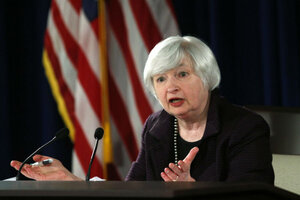Fed opens door to interest rate hike – a tribute to healing economy
Employers have been hiring at a faster clip. The official unemployment rate has fallen from 10 percent of the labor force five years ago to 5.8 percent today. Households have lightened their debt loads. And now a plunge in oil prices is acting like a holiday gift for consumers.

US Federal Reserve Chair Janet Yellen holds a news conference at the Federal Reserve in Washington, Wednesday. The Federal Reserve on Wednesday offered a strong signal that it was on track to raise interest rates sometime next year, altering a pledge to keep them near zero for a 'considerable time' in a show of confidence in the US Economy.
Kevin Lamarque/Reuters
Washington
The Federal Reserve has shifted its policy tone, replacing prior pledges to wait a “considerable time” before raising interest rates with language that simply promises to be “patient.”
A nuance, yes. But the change is seen as a vital step toward eventually lifting short-term interest rates off the floor near zero percent, where they have hovered for more than five years since the Great Recession.
Economists expect the first rate hike some time in 2015.
Higher interest rates, in general, aren’t a happy thing for the economy. But in this case it’s a sign of progress that the nation’s central bank finally feels ready to consider such a move.
Employers have been hiring at a faster clip this year. The official unemployment rate has fallen from 10 percent of the labor force five years ago to 5.8 percent today. Households have lightened their debt loads as a share of average incomes. And now a plunge in oil prices is acting like a holiday gift for consumers.
However, weaknesses remain. Worker pay is only beginning to rise again, meaningfully. Many people aren’t counted as unemployed because they grew too discouraged to look for work.
But the economy is growing and adding jobs persistently despite the phase-out of fiscal stimulus and the end of a Fed effort to add some juice by buying bonds. Tepid conditions outside the United States, although on the Fed’s radar, haven’t caused the US recovery to stall.
Until now, the Fed has relied on guidance in its statements – notably the “considerable time” phrase – as one more way to help stimulate the economy. The Fed was not only keeping its own short-term lending rate low, it was also using words to cement investor expectations that it was determined to keep interest rates low for quite a while.
Here’s the new wording from the Fed’s policy committee:
“Based on its current assessment, the Committee judges that it can be patient in beginning to normalize the stance of monetary policy.”
That’s Fedspeak for: “We’re not in any hurry, but we’re not making any promises about the timing.” It gives policymakers led by Fed Chair Janet Yellen new flexibility as they evaluate the economy to see if it has enough internal momentum to start to bring interest rates back toward levels that would historically be more normal during a recovery.
Precisely when might a rate hike come?
The answer will depend on how economic conditions evolve. Some economists say it could come as soon as March if unemployment keeps falling. Others, wary of the way rising interest rates could chill economic growth, don’t think it will happen until 2016.
The Fed statement Wednesday said inflation “has continued to run below the Committee's longer-run objective” of about 2 percent a year – implying one reason why the policy committee is hesitant to move too soon.
Still, a forecast released by the Fed Wednesday shows that, on average, Fed policymakers expect their short-term interest rate to be at about 1 percent by the end of next year. And longer run, a normal short-term rate would be about 3.75 percent, they say.

